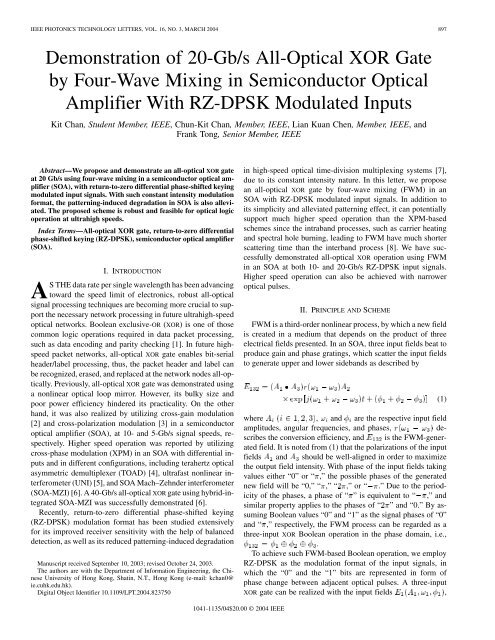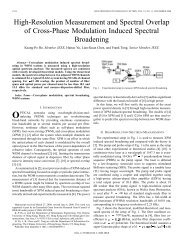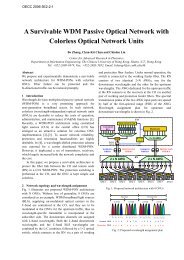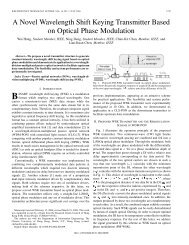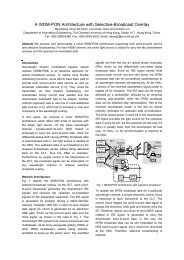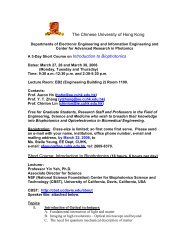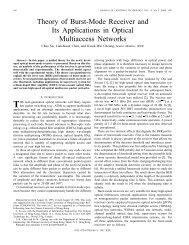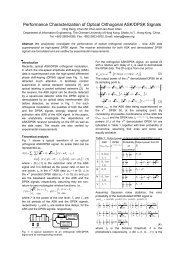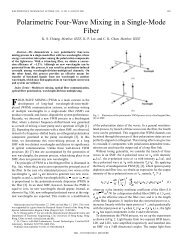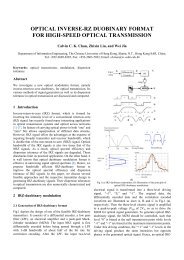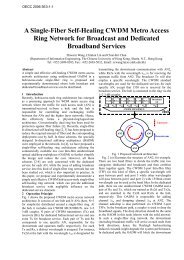Demonstration of 20-Gb/s All-Optical XOR Gate by Four-Wave ...
Demonstration of 20-Gb/s All-Optical XOR Gate by Four-Wave ...
Demonstration of 20-Gb/s All-Optical XOR Gate by Four-Wave ...
- No tags were found...
Create successful ePaper yourself
Turn your PDF publications into a flip-book with our unique Google optimized e-Paper software.
898 IEEE PHOTONICS TECHNOLOGY LETTERS, VOL. 16, NO. 3, MARCH <strong>20</strong>04Fig. 1.SOA.Experimental setup. PM: phase modulator. PC: polarization controller. Inset shows the optical spectrum <strong>of</strong> the FWM wavelengths at the output <strong>of</strong> the, and , which are all RZ-DPSKmodulated, that isand(2)where (either “0” or “1”) is the th binary value and (either“0” or “ ”) is the phase value for the th RZ-DPSK codedoptical pulse, and is the input wavelength index. When FWMoccurs in the SOA with these three input fields, one <strong>of</strong> the generatedfields has an angular frequency <strong>of</strong>, and aresultant phase <strong>of</strong>. After demodulation using adelayed-interferometer (DI), the th output binary valueisThus, the output <strong>of</strong> the DI represents the <strong>XOR</strong> Boolean operationbetween respective binary value for the input fields, , and . Hence,all-optical <strong>XOR</strong> Boolean operation can be realized <strong>by</strong> FWM <strong>of</strong>RZ-DPSK modulated input signals.III. EXPERIMENT AND DEMONSTRATIONSThe experimental setup is shown in Fig. 1. For simplicity,two-input FWM was performed in this experiment; the modified(1) becameUsing a pair <strong>of</strong> electroabsorption modulators, the RZ pulsestreams were generated at 1547 and 1551 nm, respectively. Theoptical pulses have a pulsewidth <strong>of</strong> about 15 ps and a repetitionrate <strong>of</strong> 10.61 GHz. The pulse streams were then phase-encodedseparately via optical phase modulators using 10.61-<strong>Gb</strong>/spseudorandom binary sequence (PRBS). As only two input signalswere present for FWM, the input field at a shorter wavelengthwas modulated with a depth <strong>of</strong> “ ” instead <strong>of</strong>“ ,” according to (4). After having amplified <strong>by</strong> erbium-doped(3)(4)Fig. 2. 10.61-<strong>Gb</strong>/s all-optical <strong>XOR</strong> gate demodulated input–output.(a) First input signal pattern “101 110 111;” (b) second input signal pattern“011 100 010;” obtained <strong>XOR</strong> output at the FWM-generated wavelength“110 010 101.” <strong>All</strong> waveforms are captured at the output <strong>of</strong> the DI.fiber amplifiers (EDFAs), the DPSK coded pulse streams werethen combined using a 3-dB fiber coupler. To ensure that thetwo input signals were copolarized and well aligned in the timedomain, a polarization controller and a tunable optical delayline (ODL) were inserted. However, the polarization sensitivity<strong>of</strong> the configuration could be reduced <strong>by</strong> means <strong>of</strong> polarizationdiversity technique. The SOA used in the experiment wasa commercially available (Samsung OA40B3A) SOA with asmall signal gain <strong>of</strong> 25 dB and the applied bias current wasabout 180 mA. The average power launched into the SOA wasabout 6 dBm, with the two inputs at similar power level. Fromthe output <strong>of</strong> the SOA, the FWM-generated signal at 1543 nmhad an optical signal-to-noise ratio <strong>of</strong> <strong>20</strong> dB, measured withresolution bandwidth <strong>of</strong> 0.1 nm and the conversion efficiencywas about <strong>20</strong> dB. It was then extracted <strong>by</strong> a 1-nm (full-widthat half-maximum) optical bandpass filter (BPF) before beingDPSK-demodulated via a DI with a relative delay <strong>of</strong> 94 ps. Theoutput waveform was recorded using a 45-GHz p-i-n detector.The observed waveforms are shown in Fig. 2. Fig. 2(a) and(b) shows the demodulated bit patterns for the first input signal(“101 110 111”) and the second input signal (“011 100 010”).Fig. 2(c) shows the demodulated output from the proposed alloptical<strong>XOR</strong> gate (“110 010 101”). The obtained result verified
CHAN et al.: DEMONSTRATION OF <strong>20</strong>-<strong>Gb</strong>/s ALL-OPTICAL <strong>XOR</strong> GATE BY FWM IN SOA WITH RZ-DPSK MODULATED INPUTS 899Fig. 4. BER measurement <strong>of</strong> the converted signal at 1543 nm with RZ-DPSK(10.61-<strong>Gb</strong>/s PBRS 2 0 1) modulated input at 1551 nm. Inset shows themeasured eye diagram <strong>of</strong> the converted signal.Fig. 3. 21.22-<strong>Gb</strong>/s all-optical <strong>XOR</strong> gate demodulated input–output. (a) Firstinput signal pattern “100 100 011 101 101 101 011;” (b) second inputsignal pattern “100 111 111 010 101 110 000;” obtained <strong>XOR</strong> output at theFWM-generated wavelength “000 011 100 111 000 011 011.” <strong>All</strong> waveformsare captured at the output <strong>of</strong> the DI.the effectiveness <strong>of</strong> the <strong>XOR</strong> operation <strong>by</strong> the proposed FWMmethod. The unsatisfactory extinction ratio could be caused <strong>by</strong>amplitude fluctuation at “1” and “0” level from the modulatordriver output, which led to inaccurate phase modulation duringDPSK encoding. To verify that the proposed all-optical <strong>XOR</strong> gatecould be operated at a high speed, the input signals were multiplexedto 21.22 <strong>Gb</strong>/s, before being launched into the SOA. Thecorresponding obtained <strong>XOR</strong> output was shown in Fig. 3. However,owing to the insufficient pulse extinction ratio and relativelybroad signal pulsewidth, the 21.22-<strong>Gb</strong>/s time multiplexedRZ-DPSK inputs suffered from interchannel channel crosstalk,as shown in Fig. 3(a) and (b). As a result, degraded <strong>XOR</strong> outputwas obtained, compared with the 10.61-<strong>Gb</strong>/s operation.We have also preformed bit-error-rate (BER) measurementfor the 10.61-<strong>Gb</strong>/s input signals <strong>by</strong> switching <strong>of</strong>f the phase modulationon the first signal at 1547 nm, such that the <strong>XOR</strong> gatefunctioned as a wavelength converter. The second input signalat 1551 nm was modulated with RZ-DPSK PRBS. Themeasured results are depicted in Fig. 4. It could be noticed thatthe BER curve for wavelength converted signal (at 1543 nm)was very close to the baseline with negligible power penalty( 0.1 dB). The corresponding eye diagram is also shown in theinset, which indicates clear eye opening.Compared with the XPM-based all-optical gates, in which theoperation bit rate was generally limited <strong>by</strong> the patterning effectin SOA, our proposed scheme, which employs a constant-intensityRZ-DPSK modulation format, avoids gain modulation inthe SOA, thus, the operation speed is not limited <strong>by</strong> the carrierlifetime. Therefore, higher speed <strong>XOR</strong> operation can be achievedwith sufficiently narrow optical pulses. Besides, our proposedscheme only requires the Boolean input signals to be launchedinto the SOA simultaneously; thus, it eliminates the need <strong>of</strong>using differential inputs as in the case <strong>of</strong> XPM-based interferometricconfigurations.IV. CONCLUSIONIn this letter, an all-optical <strong>XOR</strong> gate operating up to <strong>20</strong> <strong>Gb</strong>/shas been demonstrated based on FWM in an SOA with inputRZ-DPSK modulated signals. The proposed scheme has provedto be not only structurally simple and robust, but also able to effectivelyalleviate patterning-induced degradation in the SOA asa result <strong>of</strong> employing the constant intensity modulation format.With sufficiently narrow optical pulses, our proposed FWMbasedall-optical <strong>XOR</strong> gate with RZ-DPSK modulated inputs isfeasible to be operated at ultrahigh speeds.REFERENCES[1] A. J. Poustie, K. J. Blow, A. E. Kelly, and R. J. Manning, “<strong>All</strong>-opticalparity checker with bit-differential delay,” Opt. Commun., vol. 159, pp.<strong>20</strong>8–214, 1999.[2] J. H. Kim, Y. M. Jhon, Y. T. Byun, S. Lee, D. H. Woo, and S. H.Kim, “<strong>All</strong>-optical <strong>XOR</strong> gate using semiconductor optical amplifierswithout additional input beam,” IEEE Photon. Technol. Lett., vol. 14,pp. 1436–1438, Oct <strong>20</strong>02.[3] H. Soto, D. Erasme, and G. Guekos, “5-<strong>Gb</strong>/s <strong>XOR</strong> optical gate basedon cross-polarization modulation in semiconductor optical amplifiers,”IEEE Photon. Technol. Lett., vol. 13, pp. 335–337, Apr. <strong>20</strong>01.[4] K. Zoiros, T. Houbavlis, K. Vlachos, H. Avramopoulos, F. Girardin, G.Guekos, S. Hansmann, and H. Burkhard, “10 GHz Boolean <strong>XOR</strong> withsemiconductor optical amplifier fiber Sagnac gate,” in Conf. Laser andElectro-Optics (CLEO ’99), May 23–28, 1999, pp. 379–380.[5] C. Bintjas, M. Kalyvas, G. Theophilopoulos, T. Stathopoulos, H.Avramopoulos, L. Occhi, L. Schares, G. Guekos, S. Hansmann, andR. Dall’Ara, “<strong>20</strong> <strong>Gb</strong>/s all-optical <strong>XOR</strong> with UNI gate,” IEEE Photon.Technol. Lett., vol. 12, pp. 834–836, July <strong>20</strong>00.[6] R. P. Wedd, R. J. Manning, G. D. Maxwell, and A. J. Poustie, “40 <strong>Gb</strong>it/sall-optical <strong>XOR</strong> gate based on hybrid-integrated Mach–Zehnder interferometer,”Electron. Lett., vol. 39, pp. 79–80, <strong>20</strong>03.[7] K. Chan, C.-K. Chan, L. K. Chen, and F. Tong, “Mitigation <strong>of</strong> patterninduceddegradation in SOA-based all-optical OTDM demultiplexers <strong>by</strong>using RZ-DPSK modulation format,” IEEE Photon. Technol. Lett., vol.15, pp. 1264–1266, Sept. <strong>20</strong>03.[8] J. Zhou, N. Park, J. W. Dawson, K. J. Vahala, M. A. Newkirk, and B. I.Miller, “Terahertz four-wave mixing spectroscopy for study <strong>of</strong> ultrafastdynamics in a semiconductor optical amplifier,” Appl. Phys. Lett., vol.63, pp. 1179–1181, 1993.


